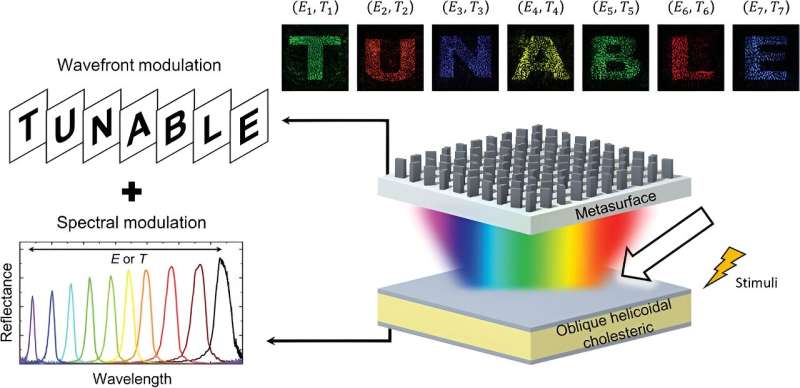This article has been reviewed according to Science X’s editorial process and policies. Editors have highlighted the following attributes while ensuring the content’s credibility:
fact-checked
peer-reviewed publication
trusted source
proofread
by Pohang University of Science and Technology

Researchers at Pohang University of Science and Technology (POSTECH) have advanced online security by integrating an AI-based metasurface with oblique helicoidal cholesteric liquid crystals.
Led by Professor Junsuk Rho from the Departments of Mechanical Engineering, Chemical Engineering, and Electrical Engineering, along with Dr. Sunae So (also a professor at Korea University) and Ph.D./MS student Joohoon Kim from the Department of Mechanical Engineering and Professor Young-Ki Kim and Ph.D./MS student Jun-Hyung Im from the Department of Chemical Engineering, the team has successfully developed ten holograms in ten different colors, seamlessly switching among them.
Their research has been published in Advanced Materials.
The rise in digital technology has made online personal data security increasingly crucial in today’s society. Encryption systems play a vital role in maintaining the stability of internet communication, serving as the cornerstone of online privacy. The realm of online security has seen a notable surge in interest regarding the fusion of metasurface technology, known for its light manipulation capabilities, with holograms.
Nonetheless, limitations have existed with respect to the amount of information that can be stored on a single metasurface.
To overcome this challenge, the research team utilized an inverse design technique driven by artificial intelligence to encode holograms with various colors and shapes across ten wavelengths ranging from 420 to 720 nanometers (nm). Additionally, they integrated an oblique helicoidal cholesterics-based wavelength modulator to accurately implement the designed holograms, even in the absence of the exact light wavelength.
The oblique helicoidal cholesterics can precisely reflect light at specific wavelengths (bandwidth < 30 nm) by adjusting the internal layered structure gap in response to external stimuli, such as electric fields and temperature, within a wide wavelength range (400 nm to 720 nm).
The research team integrated this equipment with metasurface technology to develop ten independent holograms with varying colors and shapes as switch seamlessly among them. Furthermore, they established an optical security system requiring specific electric fields and temperature conditions for the encrypted hologram to be implemented.
Professors Rho and Kim commented, “The incorporation of various external stimuli conditions, including magnetic fields, specific light wavelengths, and electric field frequencies, enables the establishment of an advanced optical encryption platform. Moreover, this technology allows for the implementation of full-color or image holograms, positioning it a core technology in the field of next-generation displays.”
More information: Joohoon Kim et al, Dynamic Hyperspectral Holography Enabled by Inverse‐Designed Metasurfaces with Oblique Helicoidal Cholesterics, Advanced Materials (2024). DOI: 10.1002/adma.202311785
Citation: Safeguarding the future of online security with AI and metasurfaces (2024, April 15) retrieved 15 April 2024 from https://techxplore.com/news/2024-04-safeguarding-future-online-ai-metasurfaces.html
This document is subject to copyright. Apart from any fair dealing for the purpose of private study or research, no part may be reproduced without the written permission. The content is provided for information purposes only.


